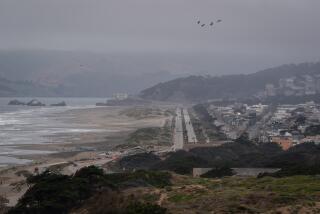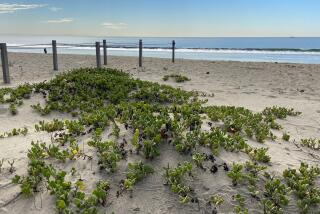Eelgrass a boon to the ecology, a bane to boaters
To some swimmers and boaters it’s a messy, gunk-filled weed, but to the federal government, this ribbon-like plant is crucial to the ecology of coastal bays.
Eelgrass, a protected species of marine life, provides sea creatures with food and protection. Yet many Newport Harbor-area residents and boat owners consider the plant a major headache. They say stringent federal protections instituted 10 years ago make it too expensive to dredge beneath their docks. They say so much silt has accumulated underwater that the keels of sailboats are scraping bottom.
“Boats are hard to use when they’re on the sand,” said home and dock owner Seymour Beek.
The city of Newport Beach is requesting an exemption from federal regulations, saying that an experimental technology used in the Bay Area is one of several new strategies that can help preserve eelgrass at a fraction of the current expense.
“We are trying to make things work for our residents, yet recognize the importance of eelgrass,” said Chris Miller, the city’s harbor resources manager. “We’re a boating harbor, a recreation harbor — we need to be able to maintain and use our boats.”
Federally protected under the Clean Water Act, eelgrass has many ecological benefits. Crabs and other herbivores eat it, and some smaller species attach to it for survival. Sand bass, California halibut and other fish use it as a nursery. Besides the shelter and food it provides, eelgrass filters excess nutrients from fertilizers and other material washed into the bay. It also oxygenates water and sediment and removes excess carbon dioxide through photosynthesis.
Dock owners who want to dredge must receive approval from the California Coastal Commission, the Army Corps of Engineers and other agencies. Dock owners must also count and then transplant all eelgrass affected during dredging. Once they’ve done that, they must also ensure that the plant thrives for another five years. If it doesn’t survive, the owner must plant anew. Critics say the process can cost tens of thousands of dollars.
“It’s a blank check,” said Mark Sites, owner of a local dredging company. “I haven’t found many people who want to take on that responsibility.”
Donna DiBari, a 25-year homeowner on Balboa Island’s South Bay Front, said she stopped dredging because of the expense. “I can understand [eelgrass] does help the bay,” she said. “But when you’re prohibiting the owner of a dock to dredge, that’s unreasonable.”
The water is so shallow in front of DiBari’s home that the ground scratches the instruments of her 30-foot Navigator powerboat, and she can no longer keep it there, she said. Like many dock owners, DiBari leases space to other boaters. She can no longer lease to sailboat owners because their keels hit sand.
Faced with complaints from boaters, the city wants to make it easier and cheaper to dredge. It proposes setting a baseline amount of eelgrass in the harbor: 20 acres in shallow water (some eelgrass grows in deep water as well). As long as the bay remained at or above that level, homeowners would be able to dredge without replanting.
It appears that officials at the National Marine Fisheries Service are receptive to the plan.
“On the one hand, we want to conserve the habitat, and on the other we want to provide some flexibility for the city and the folks that are trying to use their docks for boating,” said Bryant Chesney, a fisheries service biologist. “It’s good that a comprehensive plan is being developed because it’s hard to manage a habitat with individual homeowners.”
But Chesney is pushing for a higher baseline than the 20 acres proposed by the city.
The plan would allow 1.5 acres of eelgrass to be dredged per year so long as habitat remained above 20 acres. If it fell between 15 and 20 acres, then only 0.75 acres could be dredged, and dock owners would have to plant additional grass.
If the stock dropped below 15 acres, then the harbor would revert to the existing Southern California mitigation plan.
The replanting methods proposed by the city have been successful in other bays, including in San Francisco, but have never been tested in Southern California, according to Rick Ware, a marine biologist who consults for Newport Beach.
Also, eelgrass is dependent on uncontrollable factors, such as weather patterns. When it rains heavily, the runoff clouds the water and stunts the weed’s growth.
“You can have a plan that is all laid out on paper,” said Garry Brown, executive director of Orange County Coastkeeper, “but that doesn’t mean that nature is going to comply.”
More to Read
Sign up for Essential California
The most important California stories and recommendations in your inbox every morning.
You may occasionally receive promotional content from the Los Angeles Times.










